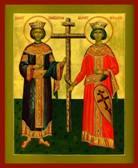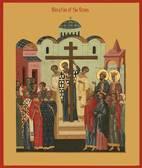Persecutions: Constantine the Great
WEEK 3: CONSTANTINE THE GREAT
 While the teacher, or three of the students, read aloud the week’s lesson, have each of the other students jot down three good discussion or quiz questions for the discussion time.
While the teacher, or three of the students, read aloud the week’s lesson, have each of the other students jot down three good discussion or quiz questions for the discussion time.
The Political Situation
As the cruel Roman Emperor, Diocletian, grew old, he decided that when he died the Empire would be divided into four parts. He appointed an auxiliary emperor, called an “Augustus” and two auxiliary “Caesars”. The northern parts, France and England, were given to Constantius Chlorus, a popular general. As a hostage for his father’s loyalty, Constantine was taken to the court of Diocletian. There he saw first-hand the persecution of Christians; many of his friends at court were, in fact, Christians. The bright and warm-hearted young man could not help but compare the spirit of the martyrs with the savagery of the Roman rulers. Constantius, Constantine’s father, on the other hand, was a wise and just man; his wife, Helen, was a Christian. Constantius was saddened by the cruelty of the other kings, especially against Christians. With the abdication of Diocletian in 305 AD, there began a bitter struggle for the emperor’s throne. Constantius took his army against the wicked King Maxentius, ruler of the rest of the Western Empire. In this battle, Constantius was killed and his son, Constantine, became king of France and England.
The Life of Constantine
Constantine was not yet a Christian; he worshipped the gods of Rome. Constantine himself was now at war with Maxentius. He knew that the future of the Empire was at stake; would he be able to reunite the crumbling Empire under his leadership? As he was crossing the Moldavian bridge, he saw in the sky a flaming cross. Written beneath this cross were the words in Latin, “In Hoc Signo Vinces,” which means, in English, “In this sign you shall conquer.” He knew that the cross was the sign of the Christians. That very night, in a dream, he saw Christ Himself, promising him victory. He decided to give the Christian God a try. He had his soldiers carry a Christian cross into battle and they won! Constantine had defeated Maxentius! He now knew that Jesus was the true God. When another of the kings, Galerius, died journeying to Rome, Constantine became ruler of the entire Western Roman Empire. The Arch of Constantine was built in Rome to commemorate his victory. His brother-in-law, Licinius, was ruler of the Eastern Empire. The first act of the two brothers was to issue a new law, the Edict of Milan, which said that Christians and all people could worship freely and build churches. But, soon, Licinius broke their agreement and began to kill Christians again. Constantine took his army and defeated Licinius in battle. Now Constantine was Emperor of the entire Roman Empire.
Constantine never forgot Who made him ruler of the Empire. He built many churches, including the first church of St. Peter in Rome. As a king, Constantine was known for his strong and wise leadership. He built a great army and navy. But, he was never fond of the city of Rome. He moved the capital of the Empire to the city of Byzantium and renamed the city Constantinople. Constantine established the Christian Church with such strength in the Byzantine Empire that the Christian Byzantine Empire stood for hundreds of years after the fall of Rome and the Western Empire. As an old man, at the very end of his life, Constantine put on the white robes and was baptized. Finally, Constantine died and left his great empire to his three sons. History books have given Constantine the title of “the Great” and the Church also remembers him and his mother Helen as great, saints “equal to the apostles.”
While the Edict of Milan actually was only a statement of tolerance, the Roman Empire under Constantine became more and more Christian. All is now smooth sailing for the Church, no longer having to hide in the catacombs and able to use imperial money for missionary work, building of churches. Right? Human nature is still human nature. And history will soon reveal that truth!
- Can a Christian Emperor resist the temptation to meddle in the doctrinal affairs of the bishops? In the selection of bishops? In their exile?
- Now that bishops have worldly power and wealth, can they begin to care more for the fleeces than for the sheep? Will bishops begin to hold temporal power as well as doctrinal?
Elevation of the Cross:
The Empress Helen, mother of the great Emperor Constantine, was traveling to the Holy Land, the land where Jesus had lived and died and risen from the dead. All the palace was in an uproar. The servants prepared food for the journey, packed the clothing, and made everything ready for the royal family to travel. The Empress was a Christian – one who believed that Jesus was the true God. She was going to the Holy Land to find the places and things the Bible told about.
Soon, the royal party – the empress, her ladies, her soldiers, and her servants reached the Holy Land. The royal ship, with its sails of purple silk trimmed with gold, landed at the port of Joppa on the Mediterranean Sea. There, camels and horses and donkeys waited to carry them inland. The road was hot and dusty; the sun beat down on them. Finally, they reached the city of Jerusalem. They could almost feel the presence of Jesus. These were the very streets He had walked about 300 years before.
Empress Helen had the servants put up silken tents on a hill outside the city. The hill was called Golgotha, a dusty mound with a few bent and twisted old olive trees growing nearby. What was special about this hill? The Bible says that Golgotha was where Jesus was crucified. No one had seen the cross on which the Lord died, but, somewhere on that dusty hill, Empress Helen was sure that she would find three crosses. The Lord had given her many dreams and visions that had started her on this journey. He would surely show her how to complete her task. Helen prayed. Then, she told her me n to begin digging, not on top of the hill, but in a little gully to the side. As they dug, the men became more and more excited. Suddenly, one of them found something wooden. It was a cross! Soon, there were three wooden crosses uncovered. But, which one was the cross of Jesus Himself?
n to begin digging, not on top of the hill, but in a little gully to the side. As they dug, the men became more and more excited. Suddenly, one of them found something wooden. It was a cross! Soon, there were three wooden crosses uncovered. But, which one was the cross of Jesus Himself?
The Bishop of Jerusalem, Macarius, suggested a way to find out. He know of a woman who was sick, so sick she was about to die. He had his servants carry the woman out to the hill. The woman was tired and wondered what was happening. Then, the bishop asked the sick woman to touch the first cross; nothing happened. She touched the second cross; nothing happened. Then she touched the third cross; suddenly she was full of energy and life and was well again. Surely this was the true cross of Christ!
The Empress Helen sent word to her son, the Emperor Constantine, that they had found the true cross of Jesus Christ. There was rejoicing in all the Christian Churches. The emperor ordered that a church be built there on the Mount of Olives. He reminded all the people that, wonderful though it was to find the wooden cross on which Jesus was crucified, we do not worship the cross but the Lord who died on it. And so it is to this day.
Discussion – his significance in the history of the Christian Church
Use the students’ discussion questions first. But if little discussion is forthcoming…The reign of Constantine is called a “turning point” in the history of the Christian Church, why? Why is he called “Constantine the Great”? Why are Constantine and Helen called “Equal to the Apostles”? Use specific definitions and historical events to back up your opinions.
Quiz Questions:
First review the quiz questions for the first two lessons of the unit verbally.
Next, use any quiz questions submitted by the students.
- Who was Constantine’s father?
- What words appeared with the cross in the sky?
- Name at least 2 rulers defeated by Constantine in battle.
- With what decree was Christianity legalized?
- Who was bishop of Jerusalem when the Holy Cross was found?